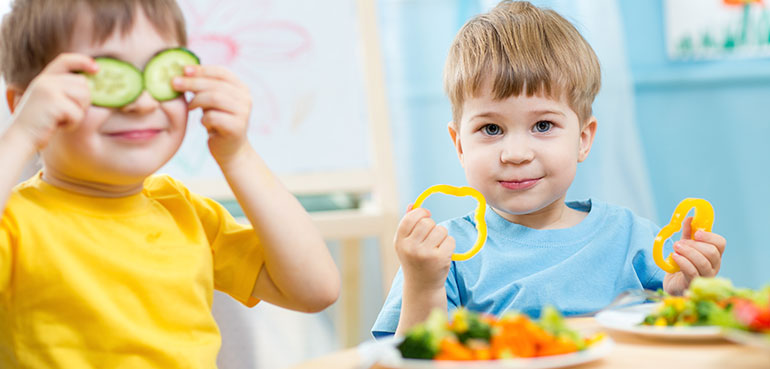If you have kids in your life, you know the struggle of enticing them to eat their veggies. The almost daily, frustrating struggle. It’s time to set aside the bribes and begging and try some new strategies to get little ones to eat those good-for-them foods at home and at restaurants. At restaurants, be sure to look for dietitian-recommended menu choices featuring servings of vegetables (along with fruits, lean proteins and whole grains). At home and eating out try these tips from Together Counts partner SPARK to help get your kids to eat their veggies.
Let’s face it–even as adults, there are certain foods that we’d prefer to avoid. However, when it comes to picky eating, it’s fair to say that children really take the biscuit. Often, as parents we struggle to convince our children to eat the right meals at the right times–even with foods we know they enjoy. Introduce a recommended daily dose of vegetables into that equation and you may have the perfect recipe for headaches, tantrums, and tears. So why bother?
As a partner of the Healthy Weight Commitment Foundation, we understand that healthy doses of vegetables can benefit your child in a number of different ways. Eating produce results in improved nutrition, enhanced performance at school, and decreased risk of childhood obesity. According to information provided by the U.S. Department of Agriculture, half of your plate should consist completely of fruits and vegetables.
Statistics have shown that only 22% of children between 2 and 5 eat their recommended daily vegetables. Fortunately for frustrated guardians, there are some tricks and tips that could help you to prompt your child into eating more veggies.
Use the “One Bite Rule”
This is a simple concept that works brilliantly on younger kids. It’s far too easy for children to decide they hate a food that they haven’t tried before just by looking at it. Push your children to try and eat at least one bite of the food that they’ve vetoed whenever you serve it. Science suggests that the more your child experiences the item, the more they’ll get used to it and begin to enjoy the taste for what it is, rather than rejecting it on principle alone.
Try to Make Food Fun
Kids love to play pretend and make games out of anything and everything. A new vegetable might be intimidating and disappointing for a child who was hoping to eat chicken nuggets, but if you turn it into a game, the task is suddenly less daunting. Transform your reluctant child into a superhero who needs to eat six carrots to see crime perfectly in the dark, or eat five pieces of broccoli for super-strength and you’ll notice the difference.
Don’t Push Too Hard–and Praise Success
If your children are working well on the “one bite” rule, try not to force them into finishing their entire plate. Punishments, fighting, and conflict develop into a negative meal experience for your child, and conditioning suggests that the more pressure and discomfort you associate with an item, the more your child will grow to dislike it. Positive reinforcement is far more productive than negative pushing.
Shop and Cook With Your Kids
A great method for getting your children to eat more vegetables, which also connects to the “make food fun” tip above, is to get them involved in the meal process. Take them out to the local supermarkets and have them pick out vegetables that they might like to try. Then, once you get home, ask the child to help you prepare the vegetables. Most children will be happier to chomp through a meal of veggies when they’re brimming with pride that they “made them” themselves.
Learn Your Child’s Vegetable Values
Some kids are under the impression that they’re invincible, so trying to convince them to eat their vegetables by telling them how healthy it is may not get you far. Instead, tempt your children with tales that their veggie portions will help them to grow bigger and stronger. Appealing to their desire to grow and overcome their limitations is much more effective than simply using the “Because I told you to” approach.
Don’t Give Up!
We all have those days where our patience seems to have met its limit, but remember that the habits you teach your child now are likely to remain with them as they progress to adulthood. For their sake, it’s important to focus on solving eating issues early. Make the kitchen a fun place and create positive connotations with vegetables. You should find that, after time, your persistence pays off.
What works best for you when getting your kids to eat healthier?
SPARK is a research-based organization that provides award-winning, evidence-based programs for Physical Education (K-12), After School, Early Childhood, and Coordinated School Health and is a member of the Together Counts Program™. Since 1989, SPARK has provided curriculum, training, and consultation to over 100,000 teachers and youth leaders worldwide. Visit www.sparkpe.org to download sample lesson plans, find grant opportunities, and register for free educational webinars and monthly eNewsletters.

